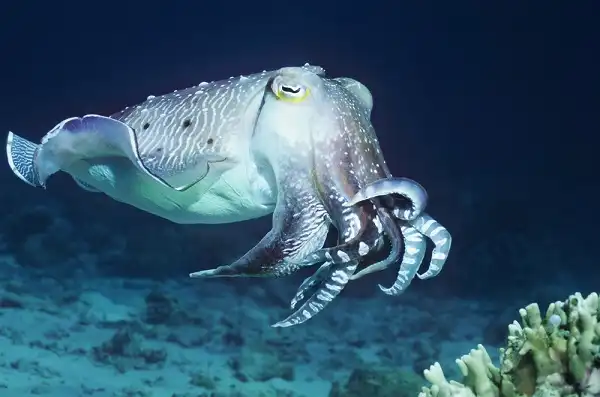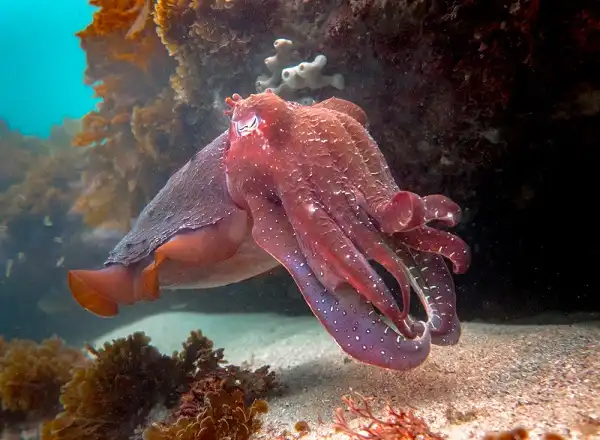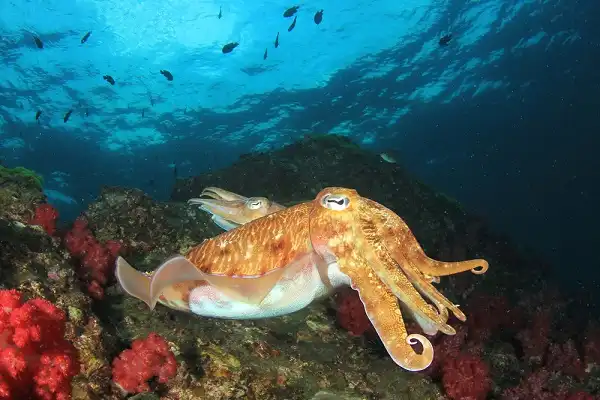Have you ever seen a cuttlefish? These fascinating creatures can be found in oceans around the globe, and their remarkable ability to adapt to different conditions makes them an interesting species to learn about. Not only are they highly intelligent, but they boast an impressive list of unique abilities that make them difficult for scientists to categorize. From rapid pigment changes that confuse predators to specialized body parts for cutting food or jet-propulsion swimming, unlock the secrets behind the amazing evolutionary strategies of this marine mollusk in this blog post!

Cuttlefish Description
Cuttlefish are remarkable, unique creatures that can be found in oceans around the globe. They are mollusks and belong to the Cephalopoda family, which also includes octopuses and squid. Cuttlefish have an elongated body with eight tentacles emerging from their head – two of which are longer than the others – as well as two eyes on either side of their head. They vary in size and color depending on species, though most have a hard external shell called a cuttlebone, which helps them maintain buoyancy underwater. Cuttlefish also possess impressive camouflage abilities thanks to specialized skin cells that contain pigments called chromatophores. These allow cuttlefish to rapidly shift their appearance to blend into their surroundings and confuse predators.
Cuttlefish Habitat
Cuttlefish can be found in a wide variety of marine habitats, from shallow coastal waters to deeper oceanic regions. They are usually found in temperate and tropical waters, though some species are also present in colder climates. These creatures tend to stick close to the seafloor or live among coral reefs and rocks, as these provide them with ample hiding spots when needed. Cuttlefish can also be seen in open water where they will often congregate during mating season. Cuttlefish prefer environments with plenty of food sources. They also require oxygen-rich water as well as adequate amounts of light for their chromatophore cells to work properly. In addition, cuttlefish rely on a consistent flow of currents that allow them to move around with ease and find new food sources when needed. The different species of cuttlefish that inhabit the world’s oceans have adapted to their respective habitats over time via natural selection. For example, those living in cold regions are known to have darker pigments for camouflage purposes while those in warmer areas tend towards lighter colors for increased camouflage effect. Similarly, some cuttlefish have evolved thicker shells or larger bodies for protection against predators or wave action in turbulent waters.
Cuttlefish Diet
Cuttlefish are carnivorous creatures and their diet consists of small fish, crabs, shrimp, and other invertebrates. They use their sharp beak-like jaws to break apart shells and cut through tougher prey items such as crustaceans or squid. Cuttlefish also employ specialized tentacles tipped with suction cups that help them catch smaller prey such as mollusks. Of course, they are also opportunistic feeders and will take advantage of any food source that is available to them. The size of a cuttlefish’s meal depends on its age and species; adults can consume larger prey than juveniles due to their increased size.
Similarly, some species may feed on larger species than others. In addition to feeding on small sea creatures, cuttlefish have also been known to scavenge for dead organisms or discarded scraps from shipwrecks or fishing boats. When it comes to digestion, cuttlefish rely heavily on enzymes found in their salivary glands located in the bottom jaw region. These enzymes help break down large food particles into smaller pieces that can be absorbed by the digestive system more easily. The digestion process has two phases – mechanical and chemical digestion – which allow the cuttlefish to extract vital nutrients such as proteins, carbohydrates, fats, vitamins, minerals, etc., from its meals.

Cuttlefish Size
Cuttlefish vary greatly in size depending on the species. The smallest cuttlefish, for example, is the Flapjack Cuttlefish which can be found in tropical waters and measures only 5 cm (2 in). On the other end of the spectrum, the largest cuttlefish species is the Giant Cuttlefish which can grow up to 50 cm (20 in) in length. However, an average adult cuttlefish can measure anywhere from 10 to 30 cm (4-12in). They generally weigh between 0.5 kg and 4 kg (1-9 lbs) depending on age and species. Even with their diverse sizes, they all possess an internal shell called a cuttlebone that helps them maintain buoyancy underwater.
Cuttlefish Lifespan
Cuttlefish generally have a relatively short lifespan compared to other species of marine creatures. The average lifespan for most cuttlefish is between 1 and 2 years, though this timeline can vary significantly depending on the species. For instance, some may reach maturity within 6 months while others may take up to 18 months before reaching adulthood. The lifespans of cuttlefish are largely determined by a variety of factors including their diet, habitat, and available resources. Cuttlefish that live in warmer waters tend to have shorter lifespans than those living in cooler regions due to the increased competition from predators and other aquatic creatures. Similarly, those with access to ample food sources will typically live longer than those that have to compete over limited resources.
Cuttlefish Behavior
Cuttlefish are highly intelligent creatures and have evolved a unique set of behaviors that help them survive in their oceanic habitats. They use their remarkable camouflage abilities to blend into their surroundings, making it difficult for predators to spot them. Through a process called counter-illumination, they can also manipulate their bodies to match the intensity of light coming from below them to make themselves even harder to detect. In addition, cuttlefish possess an impressive array of sensory organs which allow them to taste, smell, and feel their way through the water as they search for food and potential mates. These specialized organs also pick up on vibrations in the water which helps the cuttlefish identify predators and other threats in its environment. When it comes to mating, male cuttlefish use a variety of courtship behaviors such as flashing colors or waving arms in order to attract females while also intimidating other males away from the potential mate. During this time, females are more likely to seek out larger males due to the fact that they tend to be better providers and protectors for offspring.

Cuttlefish Speed
Cuttlefish are known for their remarkable speed and agility in the water. Their undulating fins, which run along their body, allow them to move rapidly through the water with incredible bursts of speed. They have been clocked at speeds of up to 22 km/h (14 mph), allowing them to outmaneuver many of their predators. In addition, cuttlefish can quickly change direction thanks to their unique anatomy. Cuttlefish have a special organ called a funnel which helps them regulate the amount of water flowing through their bodies. By adjusting this flow, they can move rapidly and build up momentum on one side or the other in order to make tight turns and sudden changes in direction. This ability is further enhanced by their flexible arms and tentacles which can be used as steering mechanisms when needed. Along with this, cuttlefish possess an impressive array of sensory organs that help them detect even the slightest movements in the water around them, allowing them to respond quickly and accurately if they sense any potential danger nearby.
Cuttlefish Hunting
Cuttlefish are skilled hunters that employ a variety of techniques to catch their prey. They use a mix of ambush tactics as well as active hunting in order to get the most out of their meals. When hunting actively, cuttlefish will search for potential food sources such as small fish or crustaceans, and then pursue them with swift agility and bursts of speed. In addition to this, cuttlefish have evolved an impressive array of defensive mechanisms which allow them to capture prey more efficiently. This includes the use of camouflage which helps them to hide in plain sight while waiting for unsuspecting victims.
Cuttlefish can also produce electric fields from their bodies which allow them to detect the movement of nearby prey even when hidden from view. Another tactic used by cuttlefish when hunting is their signature jet propulsion technique which allows them to shoot forward at lightning speed in order to quickly grab hold of unsuspecting prey items. This impressive maneuver requires precise timing and control over water pressure within the body which is enabled by their unique muscular system and funnel organ.
Cuttlefish Reproduction
Cuttlefish reproduction is a remarkable process that allows these creatures to sustain their population in the oceanic habitats they inhabit. Females typically lay hundreds of eggs on rocks and other hard surfaces, with the number varying depending on the species. The eggs are then fertilized by males who release sperm into the water column to reach them. Once the eggs have been laid, both sexes leave and abandon them. The eggs are then left to incubate and hatch within a few weeks or months depending on environmental conditions such as temperature and food availability. Upon hatching, the newly-hatched cuttlefish will seek out food and begin exploring their surroundings in order to survive. During mating season, which generally occurs around autumn in temperate regions, female cuttlefish will congregate in large groups where courtship can take place. Males will then use various displays such as color changes and arm-waving motions to attract potential mates and compete for reproductive opportunities. In some cases, males may even fight off rivals using their powerful tentacles if necessary!

Cuttlefish Communication
Cuttlefish possess an impressive array of communication skills that aid them in their daily lives. These animals are capable of expressing a wide range of signals and behaviors that allow them to interact with others in their environment. Using their unique body language and color-changing abilities, cuttlefish can effectively communicate with other members of their species as well as potential mates. For instance, males may show off bright colors and patterns while waving their arms and fins in order to attract potential females during mating season. By doing this, males demonstrate their strength and vigor which are often seen as desirable traits by females. In addition to this, cuttlefish also produce electric fields from their bodies that act as invisible signals which can be detected by other nearby individuals.
Conclusion
Cuttlefish are fascinating creatures that have evolved over millions of years to become highly efficient predators in their marine habitats. From their impressive array of sensory organs to the sophisticated communication skills they possess, these animals are capable of demonstrating some remarkable adaptive traits which allow them to remain at the top of the food chain. From hunting tactics such as ambush and jet propulsion maneuvers to reproductive strategies like courtship displays and egg protection, cuttlefish have consistently demonstrated an impressive level of adaptability which has enabled them to continue thriving in the wild for millions of years! Therefore, it is clear that these remarkable aquatic animals will remain at the forefront of our ocean ecosystems for many more years to come!
Frequently Asked Question

